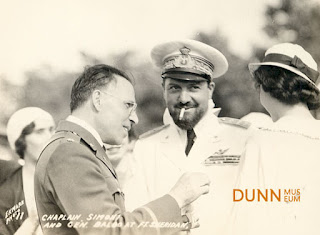
World's Fair poster, 1933. Source: online
The Century of Progress celebrated the city's centennial. The Fair became known for many things, including appearances by future stars Judy Garland and the Andrews Sisters, Art Deco buildings, and exhibits relating to its' theme of technological innovation.
It was likely the emphasis on innovation and the chance for publicity that lured fascist leader, and Italian Air Marshall, Italo Balbo (1896-1940), to the Century of Progress.
In 1922, Balbo was one of four men who brought Benito Mussolini to power in Italy. He served as Mussolini's general of militia and minister of aviation. Although he knew nothing about aviation when he was appointed, Balbo quickly learned to fly and set out to re-organize Italy's air force.
Balbo's flying boat from "Official Book of the Flight of General Italo Balbo and His Italian Air Armada
to a Century of Progress Chicago 1933." Online via University of Chicago Library.
Balbo was eager to promote advances in Italian aircraft and made a spectacular trans-Atlantic flight to Chicago for the Century of Progress in 1933. He led 24 Savoia-Marchetti S-55 double-hulled flying boats from Italy to land in Lake Michigan in just over 48 hours, setting records for speed, payload, altitude and range.
The planes maintained a tight "V" formation for the entire Atlantic crossing. To this day, pilots often refer to a large formation of aircraft as a "Balbo."
When the planes landed in Lake Michigan it was reported as one of the proudest moments for Chicago's Italian community. At the time, many Americans supported Mussolini and his fascist regime. It was not until the United States declared war on Italy in 1941 when that sentiment changed sharply.
Balbo at Fort Sheridan with Chaplain Aristeo Simoni. Dunn Museum, 92.24.688.
The Chicago visit included mass at Holy Name Cathedral celebrated by Cardinal Mundelein, who in 1924 had a town in Lake County named in his honor.
After returning to Italy, Balbo became Mussolini's possible heir. In 1938, Balbo met with Aldolf Hitler. Two years later, Balbo was killed in an air crash in Libya. Some have claimed that his plane was shot down mistakenly by his own military.
Chicago retains two reminders of General Italo Balbo's famous visit. The most prominent one is Balbo Drive. Then Mayor Ed Kelly capitalized on the excitment of the visit by renaming 7th Street in Balbo's honor.
The second landmark was a gift from Mussolini, who donated an ancient Roman column from the temple in Ostia to the people of Chicago, to commemorate Balbo's voyage and to symbolize the greatness of Fascist Italy. The column now stands as the last remnant--in its original spot--from the Century of Progress exhibition. It is located a few feet off Chicago's lakefront bike path, and within a hundred yards of Soldier Field.



2 comments:
WOuld it be possible to get a copy of the photograph of CH Simoni with Gen Balbo?
For the U.S. Army Chaplain Corps Museum.
The museum has two photographs of Chaplain Simoni with General Balbo from the same event. Please email me to discuss lcha@lcfpd.org Thank you for your interest.
Diana
Post a Comment